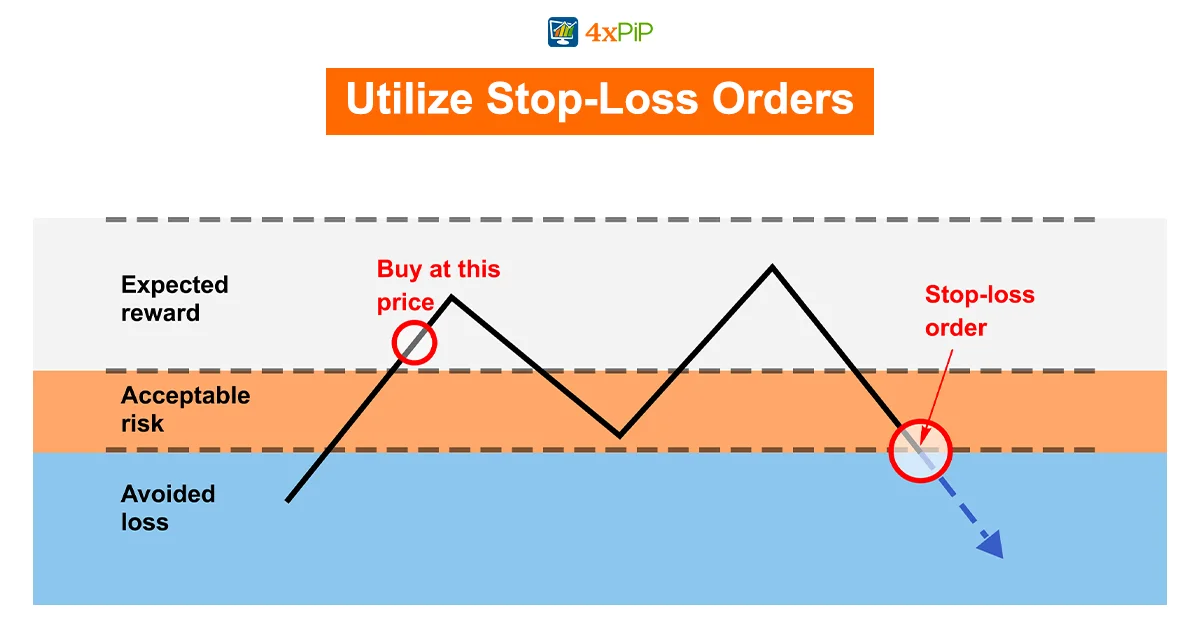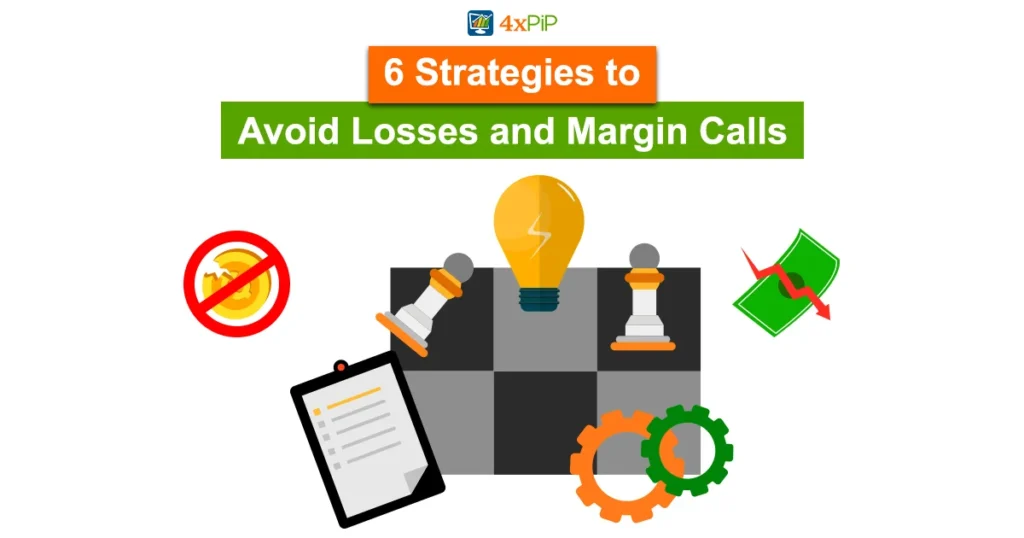Climbing on board the journey of forex trading demands more than just market insights; it requires a vigilant shield against potential losses and margin calls. The synergy of market volatility, economic indicators, and emotions necessitates a robust risk management strategy. This comprehensive guide, brought to you by 4xPip, a trusted source for trading tools and expert guidance, dives into six effective strategies to fortify your trading account, ensuring resilience in the face of challenges. For more information and personalized support, contact 4xPip at [email protected].
-
Utilize Stop-Loss Orders:

Implementing stop-loss orders is akin to placing a safety net beneath your trading positions. These orders serve as a proactive measure to limit potential losses. For instance, if you purchase EUR/USD at 1.2000, setting a sell stop order at 1.1950 ensures that the system automatically initiates a sell action should the currency pair dip below 1.1950. This tactical approach not only prevents your losses from escalating but also frees you from the emotional burden of holding onto a losing trade for too long.
Beyond mere protection, stop-loss orders are a manifestation of discipline and strategy. They embody a predetermined exit point, a crucial component of any successful trading plan. As the market is inherently unpredictable, setting specific parameters for your trades allows you to manage risk effectively and steer clear of impulsive decisions.
-
Master Proper Position Sizing:
Position sizing is a cornerstone of sound risk management. It involves determining the appropriate allocation of your trading capital to individual trades. This calculated approach hinges on factors such as your risk tolerance, trading style, and prevailing market conditions. Consider the scenario of a $10,000 trading account. Adhering to the 1% to 2% risk rule implies not exposing more than $100 to $200 per trade. This methodical allocation ensures that even a string of unfortunate trades won’t cripple your overall trading capital.
Proper position sizing acts as a protective shield against the inherent uncertainties of the forex market. It instills prudence by limiting the potential impact of individual trades on your overall portfolio. The emphasis here is not merely on maximizing profits but on preserving capital, a foundational principle for long-term success in the dynamic world of forex trading.
-
Embrace Diversification:
Diversification is a strategy that echoes the age-old wisdom of not putting all your eggs in one basket. In the context of forex trading, diversification involves spreading your risk across different markets, instruments, time frames, and trading strategies. The rationale is straightforward – if one segment of your portfolio falters due to external factors, the diversified nature of your investments allows you to offset losses with other well-performing assets.
Consider a scenario where geopolitical tensions negatively impact a specific currency pair or sector. If your investments are diversified, the losses incurred in that segment can be mitigated by gains in other areas of your portfolio. Diversification is not just a risk mitigation tool; it’s a strategic approach to ensure that your trading capital remains resilient amidst the unpredictable ebbs and flows of the forex market.
-
Craft a Solid Exit Strategy:
An exit strategy is your roadmap for gracefully exiting trades, whether to lock in profits or cut losses. It acts as a compass, guiding your decisions based on predetermined criteria rather than emotional reactions. This strategic approach to exiting trades is indispensable for disciplined trading, especially in the face of fluctuating market conditions.
Your exit strategy should be comprehensive, incorporating factors such as specific price levels, technical indicators, or signals from fellow traders. It’s not merely a reactionary measure but a premeditated plan that aligns with your overall trading objectives. By defining your exit strategy in advance, you shield yourself from impulsive decisions driven by market sentiments or unforeseen events.
-
Maintain Emotional Control:
Emotions play a pivotal role in trading, often acting as silent influencers that can significantly impact your decisions and, consequently, your bottom line. Fear, greed, and frustration are familiar companions to every trader, and managing these emotions is paramount for sustained success in the forex market.
Setting realistic goals and expectations serves as the initial step in emotional control. It provides a framework for your trading endeavors, aligning your aspirations with the inherent realities of the market. Following a consistent routine and discipline further fortify your emotional resilience. A trading journal becomes your mirror, reflecting on your decisions and emotions, aiding in self-awareness and improvement.
Continuous learning, another key element in emotional control, involves deriving insights from both successes and failures. Seeking feedback and advice from fellow traders or experts establishes a support system, creating an environment where emotional pitfalls can be identified and rectified. In the unpredictable landscape of forex trading, emotional control is not a luxury but a prerequisite for sustainable success.
-
Guard Against Margin Calls:
A margin call is a sobering reminder of the financial realities in forex trading. It’s a call from your broker demanding additional funds or securities to maintain the minimum required margin level. Failing to meet this call could result in the liquidation of your positions, translating into actual losses for you.
To shield yourself from the specter of a margin call, a judicious approach to leverage is essential. Leverage, the ratio of borrowed funds to your own, magnifies both gains and losses. While it allows you to control larger positions with less money, it significantly elevates your risk. A conservative rule of thumb advises not exceeding 50% leverage. For instance, with a $10,000 account, limiting borrowed funds to $5,000 is a precautionary measure against excessive risk.
Regularly monitoring your account balance, equity, margin loan, and margin level is the frontline defense against margin calls. These indicators provide real-time insights into the health of your trading account. If any of these values fall below the minimum required margin level, a margin call is imminent. Stay vigilant, and you’ll be better equipped to navigate the financial terrain without succumbing to the pressures of a margin call.
Utilizing stop-loss or trailing stop orders further fortifies your defense against margin calls. These automated orders kick in when your positions reach specified price levels, providing a safety net against potential losses. Setting realistic expectations and goals, trading with funds you can afford to lose, and having a clear trading plan are integral elements of a robust defense against margin calls.
In the dynamic and volatile world of forex trading, learning from mistakes is not just a valuable trait but a survival skill. Regularly reviewing your trading performance, seeking feedback, and analyzing both successes and failures contribute to a continuous improvement cycle. In the quest for financial success, the ability to adapt, learn, and fortify your trading approach is a journey, not a destination.
Summary:
In conclusion, protecting your trading account is not a singular act but an overall approach that combines discipline, strategy, and resilience. We’ve explored six crucial strategies to safeguard your trading account from potential losses and margin calls in the dynamic forex market. From leveraging stop-loss orders and mastering position sizing to embracing diversification and maintaining emotional control, these strategies form a robust defense against market uncertainties. Additionally, prudent exit strategies and vigilant monitoring to prevent margin calls contribute to a holistic approach to risk management. By integrating these strategies into your trading routine, you can navigate the complexities of forex trading with resilience and discipline.





